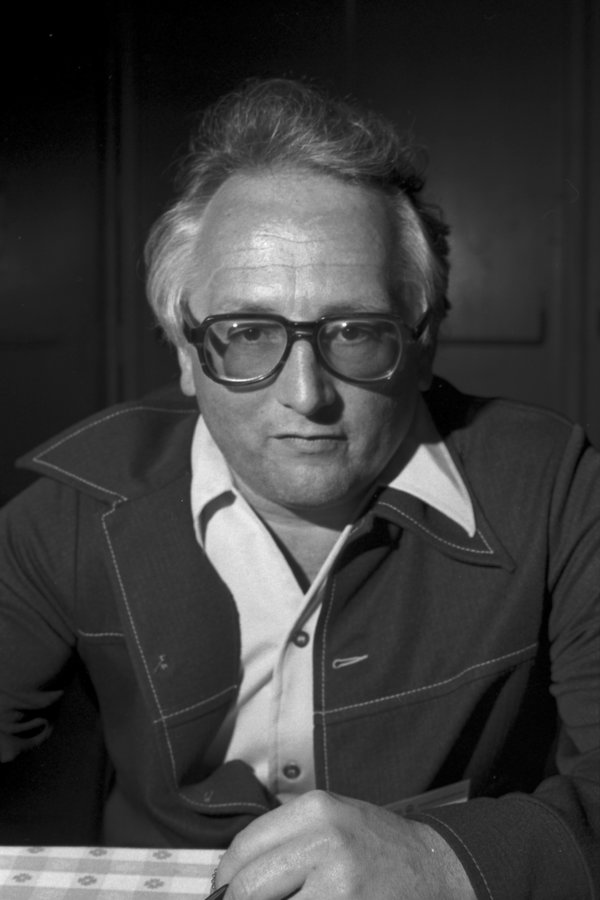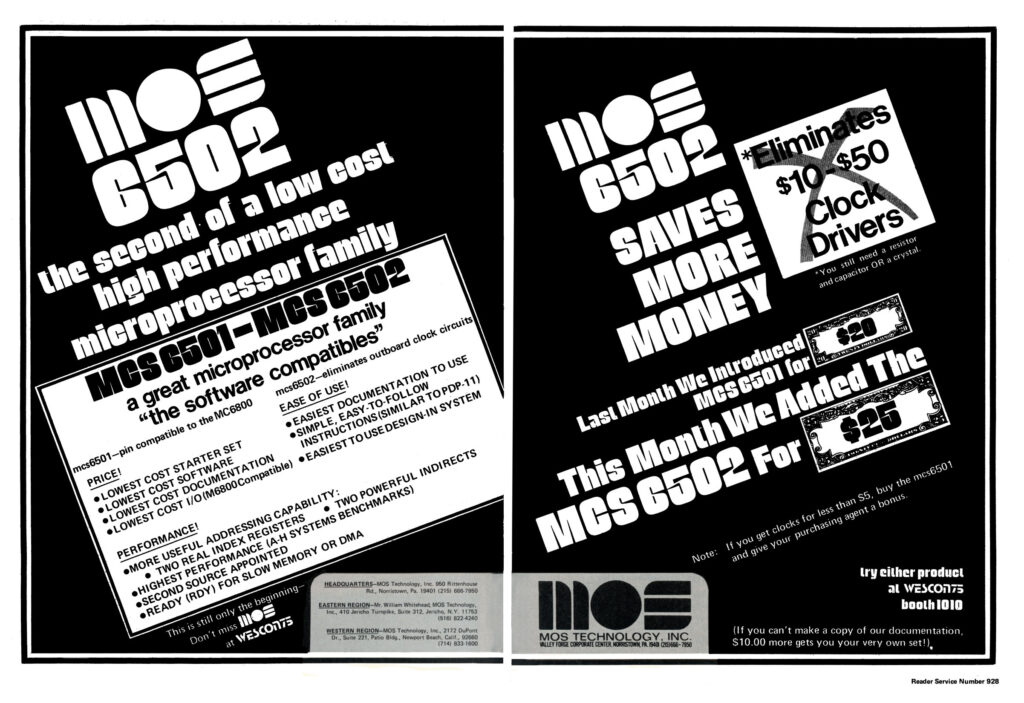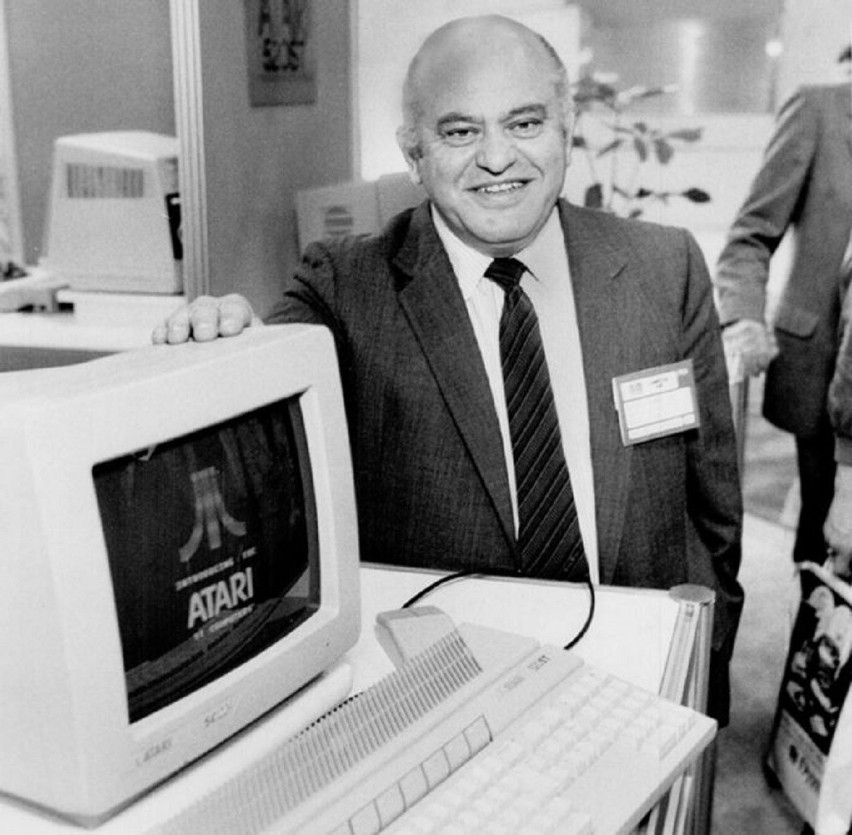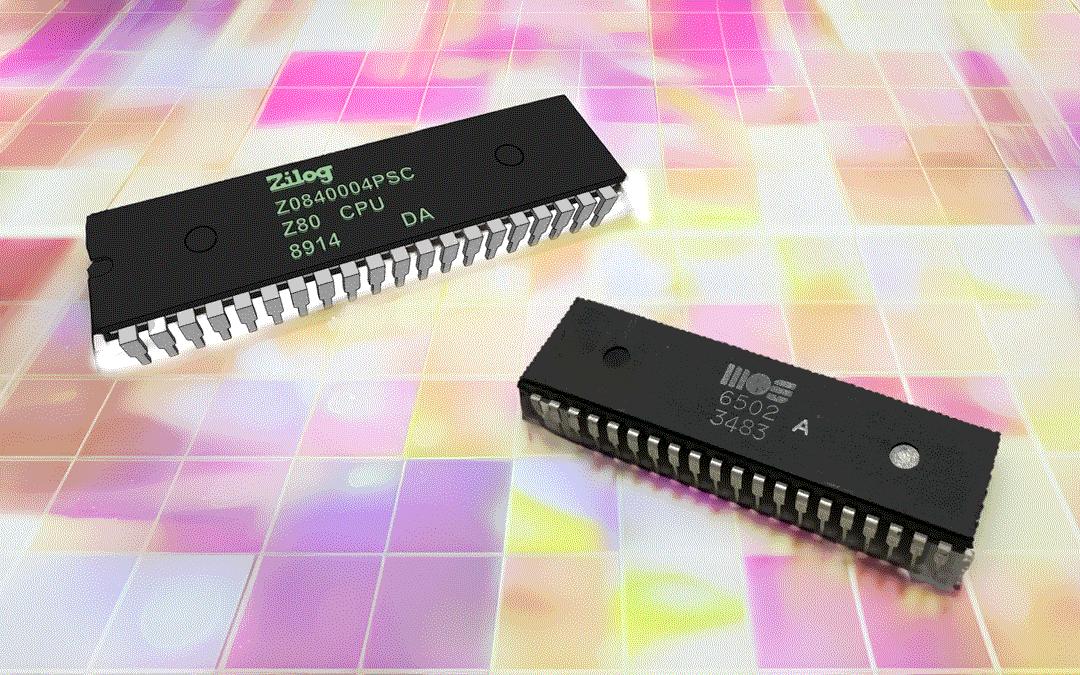The two classic rival CPUs
Move over, AMD vs. Intel: there’s a classic rivalry in the computing world that arguably laid the groundwork for modern personal computing and gaming.
When reading a short list of examples of modern 8-bit computers that was recently published on RetroFun.PL, you might notice that they are almost exclusively either based on Zilog Z80 or MOS 6502. Wonder why?
The Zilog Z80 and MOS 6502 microprocessors powered the dreams of a generation, from the iconic Commodore 64 to the game-changing Nintendo Entertainment System. These two chips, with their distinct architectures and capabilities, fueled not just computers and consoles but a revolution in how we interact with technology. This story isn’t just about silicon rivalry; it’s about how these CPUs shaped the digital age, from the arcade to the desktop, and beyond.
The numbers
Z80 is clearly better in… Just kidding. These two CPUs are just different, and the computers they were used in may have had some different goals as well. There is also no clear estimate on how many device models used each of them.
Best-selling computers and consoles
For sure, both sold in millions, even within a single computer model, or gaming console model.
Zilog Z80
- Amstrad CPC: 3 million
- Amstrad PCW: 8 million
- ZX81: 1.5 million
- ZX Spectrum: 5 million
- MSX: ~10 million (sources give numbers from 6M to 11M)
- Sega Master System: 10-13 million
- Sega Game Gear: 11 million
- Sega Mega Drive (Z80 being the helper CPU): 33 million
- Nintendo Game Boy: 118 million (!!!)… but Z80 is not exactly the CPU in it.
MOS 6502:
- Commodore VIC-20: 3 million
- Commodore 64: 12.5 ~ 17 million!
- Commodore 1541 (disk drive! had 6502 CPU too): hundreds of thousands?1
- Apple II: 6 million
- Atari Lynx: 2 million
- Nintendo Entertainment System: 61~65 million!
These numbers clearly tell us that the only clear winner of the market battle was Nintendo, not one or the other CPU. At some point, kids in American houses in the 80s used to say “to play Nintendo” rather than “to play video games” (a phrase used, albeit a little misplaced in time, in “Stranger Things” too :)).
Noteworthy: Amstrad CPC was marketed as a “serious” computer, didn’t originally intend to be a gaming machine, same with Amstrad PCW (this one clearly isn’t remembered as a gaming one). But MSX, the Segas and the Game Boy definitely were amazing gaming machines, proving that Z80 is good for both professional and gaming usages.
Apple II and Commodore 64 were the main products with the 6502 in the US market, also being perceived as a business vs gaming machine.
The history
Intel 8080
In 1974, the Intel 8080 CPU appeared on the market, at the cost of $360 per unit. This CPU and its price will be an important point of reference. It was a successor to the 8008, an 8-bit CPU from 1972, that could address up to 16 KB of memory.
The 8008 could work at 800kHz (not MHz!) speed at maximum, but solved a problem of integrating multiple internal components of a CTC DataPoint 2200 computer, and its overheating. The 8008 was designed by CTC – Computer Terminal Corporation.
The 8080 started at 2MHz and supported up to 3.125 MHz clock speed, and it could address 64 KB of memory. It was used in the Altair 8800 and subsequent S-100 bus personal computers until it was replaced by the Z80 in this role, and was the original target CPU for CP/M operating systems developed by Gary Kildall.
It was also Intels own design: Federico Faggin proposed the 8080 architecture to Intel’s management in 1972 and got permission to develop it six months later. He hired Masatoshi Shima to help with the design in November 1972.
MOS 6502
In 1975, the MOS 6502 was introduced at a price of $25. The price actually came up early, before the CPU was designed.

Chuck Peddle, a lead engineer at Motorola, was asking their customers what price tag would make it possible to use a CPU in a mass market product. That wasn’t a thing yet. Motorola was selling the Motorola 6800, but it cost $300 (in 2024 that would be $1740, per usinflationcalculator.com), which severely limited applications. Lowering that to $25 (today’s $145) would make it at least possible to deliver more complex electronic devices to a non-enterprise consumer. Chuck tried to convince Motorola to create a low-cost model of their CPU, but the management was not interested, and they officially asked him to stop working on it. Seeing an opportunity, Peddle and his team left Motorola to join MOS Technology, Inc., where they aimed to create a low-cost, high-performance microprocessor.
At MOS Technology, the team set out to design a chip that would be affordable for the mass market while still offering good performance. They applied several innovative design techniques and leveraged their experience from working on the 6800 to create a new processor architecture. One of their key goals was to reduce the chip’s complexity and the cost of production, which they achieved by simplifying the design and using fewer transistors than competitors like the Intel 8080.

In 1976, Commodore International, under the leadership of Jack Tramiel, acquired MOS Technology, Inc. This acquisition was a strategic move by Commodore, primarily motivated by their need for a reliable supply of microprocessors for their own range of personal computers and calculators. Jack believed strongly in vertical integration – if a company owns the entire manufacturing and sales process, from the components, to direct contact with the resellers, it will be able to cut margins and prices more than any of their competitors.
At the time, MOS Technology was facing financial difficulties, despite the success and potential of the 6502 microprocessor. The financial strain was partly due to the aggressive pricing strategy of the 6502, which, while successful in capturing market share, put pressure on the company’s margins.
The acquisition proved to be beneficial for both parties. For MOS Technology, it provided the necessary financial stability and resources to continue their operations and innovation. For Commodore, it ensured access to a critical technology that would power many of its future products, including the Commodore PET, VIC-20, and the Commodore 64, the latter becoming one of the best-selling personal computers of all time.
It was a perfect synergy. The price of the CPU and the acquisition helped reduce the price of the computer, while the Commodore computers’ market success made the 6502 extremely widely used in turn, and ensured the continued influence of the MOS 6502 microprocessor in the development of computing technology.
By the way, if you want to get to know first-hand details on how these computers got so successful from a product management perspective, I highly recommend the 1984 book “The Home Computer Wars” by Michael Tomczyk.
MOS was not by any means producing the 6502 exclusively for Commodore. Indirectly, Commodore earned from the widespread adoption of the MOS 6502 in the industry by selling the chip to other companies for use in their products.
- 1975: The MOS 6502 microprocessor was introduced by MOS Technology, Inc.
- 1976: Commodore International, led by Jack Tramiel, acquired MOS Technology. This acquisition was primarily motivated by Commodore’s need for a reliable supply of microprocessors for its own range of personal computers and calculators.
- 1976: Apple Inc. used the MOS 6502 microprocessor in its very first computer, the Apple I. The Apple I was designed and hand-built by Steve Wozniak, one of Apple’s co-founders, and it was one of the earliest personal computers to come as a fully assembled circuit board, although it lacked a case, power supply, keyboard, and monitor.
- 1977: Following the Apple I, Apple continued to use the MOS 6502 (or variations thereof) in the Apple II series. The Apple II was a significant product in the history of computing—it popularized personal computing, especially in the US, and had a long production run until 1993 in various models and upgrades.
- 1977: Atari released the Atari 2600 video game console, which utilized the MOS 6502 microprocessor.
- 1978, MOS was selling the 1.79 MHz version and an IO chip to Atari for $12 per set, as the production cost was as low as $4.
- 1979: Atari 400/800: these were Atari’s first entries into the personal computer market.
- 1980: Commodore VIC-20: Introduced in 1980, it was the first computer of any kind to sell one million units. The VIC-20 was an affordable home computer that also used a variant of the 6502 processor.
- 1981: BBC Micro: developed by Acorn Computers Ltd for the BBC Computer Literacy Project in the UK.
- 1982: Commodore 64: the C64 became one of the most successful home computers of all time, with estimates of sales ranging up to 17 million units. It was powered by a version of the 6502 processor, known as the 6510.
- 1983 (Japan), 1985 (North America), 1986 (Europe): Nintendo Entertainment System – the NES used a custom variant of the 6502 processor, known as the Ricoh 2A03 in North America and the Ricoh 2A07 in Europe. While built by Ricoh, it was licensed from MOS. This variant removed the “decimal mode” (operating on Binary Coded Decimals) support, but added sound and controller input handling capabilities.
By owning MOS Technology, Commodore not only secured a critical supply chain for its own products but also capitalized on the chip’s popularity across the burgeoning personal computing and video game industries. The success and widespread adoption of the 6502 microprocessor thus contributed to Commodore’s financial success, both through direct product sales and through component sales to other manufacturers.
Tramiel, Commodore, Atari, and what was there after the 6502
While Commodore and Atari were rivals in the home computer market, and their gaming market as well, they had something in common, although at different times – their owner. Jack Tramiel, the founder of Commodore, born in the same city as I was (Łódź, Poland).
After leaving Commodore in 1984, Jack Tramiel founded Tramel Technology, Ltd (the spelling was later changed to Tramiel Technology, Ltd to ensure correct pronunciation). His departure from Commodore was due to disagreements with the board over the company’s direction. Shortly after founding his new company, Tramiel turned his attention to Atari.

At that time, Atari, Inc., once a giant in the video game industry, was struggling financially due to the video game crash of 1983 and internal challenges. Warner Communications, Atari’s parent company, was looking to divest itself of its troublesome video game division.
In July 1984, Jack Tramiel acquired the Consumer Division of Atari, Inc. from Warner Communications. This part of Atari was responsible for home video games and home computers. The deal did not include the arcade division, which was retained by Warner Communications and later spun off as Atari Games.
Oh, yeah, how did it end up owned by Warner in the first place…? Don’t you love how history is a maze where every step gives you a few options for new branches to turn into? For now, I can recommend the “Once upon Atari” book by Howard Scott Warshaw. Please let me know if that’s something to delve into!
Before Tramiel’s departure, Commodore was in the process of looking for advanced technology to secure its future in the personal computer market. This led them to the Amiga Corporation, which was developing a powerful new computer known as the Amiga. Initially, Amiga Corporation was in talks with Atari regarding a potential investment or acquisition. Atari, under Warner Communications at the time, had funded Amiga’s development to some extent.
However, after Tramiel acquired Atari and shifted its focus, and with Amiga Corporation facing financial difficulties, Commodore stepped in and acquired Amiga Corporation in 1984. This move provided Commodore with the advanced technology it sought. The first model released was the Amiga 1000 in 1985, which showcased groundbreaking graphics and sound capabilities far beyond what was possible with the 6502-based systems.
Either way, in 1985 we had the Amiga and the Atari ST, both using the Motorola 68000 series of microprocessors, which were more powerful than the 6502 and allowed for more advanced graphics, audio, and multitasking capabilities. The Amiga’s use of the Motorola 68000 was a significant factor in its success as a multimedia and gaming platform, while the Atari ST’s support for MIDI, an interface and data format for music devices such as keyboards or sequencers, made it popular especially with the musicians.
While the 68000 sounds like an extension to the 6800, it was not. Motorola decided to start from scratch, not aiming for any compatibility. Any architectural similarities and limitations are usually attributed to the fact that both were still inspired by PDP-11 – a computer from the 70s. And we’re already off-topic!
Back to the 70s, then!
Z80
We started from the Intel 8008 and 8080.

The Z80 microprocessor, a significant advancement in computer technology during the 1970s, was the brainchild of Federico Faggin. After contributing monumentally to the development of the Intel 4004, 4040, 8008, and 8080 microprocessors, Faggin decided to leave Intel due to various professional letdowns, including a clash with management and under-appreciation of his contributions (not to mention Intel patenting processes Faggin invented at Fairchild, his previous employer).
In late summer of 1974, Federico Faggin decided to start his own company, aiming to innovate further in the microprocessor industry. He teamed up with Ralph Ungerman, a colleague from Intel, to establish Zilog. He envisioned creating a superior processor that would outperform Intel’s 8080, emphasizing enhancements such as a better register model, advanced instructions, and a more versatile interrupt structure. This envisioned processor was to be the Z80.
The Z80 was designed to be binary compatible with the Intel 8080, meaning it could run software written for the 8080 without modification. This compatibility was a significant advantage, as it allowed manufacturers and developers to migrate to the Z80 without abandoning their existing software investments.
Despite its advanced features, the Z80 was competitively priced, making it an attractive option for computer manufacturers looking to offer powerful yet affordable products.

In the initial advertisements, you can notice it mostly boasted much easier powering (just 5V), incorporated DRAM refresh control (Dynamic Random Access Memory needs to be refreshed periodically to maintain the values stored in it; if you chose Intel, you had to have separate circuitry to do that), and having many more instructions and OP Codes than Intel. Was this good, or just added cost? We got this covered in the “Is more complex better?” section.
So here, the timeline was:
- 1974: Intel introduces the 8080. The 8080 became widely popular and is often regarded as the processor that truly kicked off the personal computer revolution. It was used in various early computers, including the Altair 8800, which is credited with sparking the home computer era.
- 1976: The Zilog Z80 was released. Designed by former Intel engineers, the Z80 was binary compatible with the 8080 but added enhancements such as a larger set of registers and new instructions.
- 1977: Tandy Radio Shack TRS-80 Model I – One of the first home computers to become commercially successful, making personal computing accessible to a broader audience.
- 1978: Intel introduced the 8086, a significant leap forward as it was a 16-bit processor. The 8086 laid the groundwork for the x86 architecture, which would dominate personal computing for decades. Its introduction marked the beginning of a transition from 8-bit to 16-bit computing in the industry.
- 1979: The Intel 8088, a variant of the 8086 with an 8-bit external data bus, was released. This design choice made it cheaper to implement and allowed it to use existing 8-bit peripherals and memory systems, making it a practical choice for cost-effective personal computers.
- 1980: Sinclair ZX80, followed by ZX81 in 1981 – A pioneering British home computer, notable for its low price and compact design, making it accessible to many users. Uses Z80.
- 1980: Epson HX-20 – Often considered the first “laptop” computer, featuring a built-in printer and small LCD screen. Uses Z80. I own one, so I could show it in a video!
- 1980, 1981, various years: Numerous arcade machines – The Z80 was commonly used in arcade game systems throughout the late 1970s and 1980s, powering classics like “Pac-Man” (1980) and “Galaga” (1981).
- 1981: The most famous use of the 8088 was in the original IBM PC, model 5150, launched in 1981.
- 1982: Sinclair ZX Spectrum – Famous for its role in popularizing home computing and video gaming in the UK. It had a vast library of games and software. Uses Z80.
- 1982: ColecoVision – A Z80-powered home video game console offering near-arcade-quality graphics and gameplay, competing directly with the Atari 2600.
- 1983: MSX – A standardized home computer architecture, popular in Japan, South Korea, and South America. Many models from various manufacturers used the Z80.
- 1984: Amstrad CPC series – A line of personal Z80-powered computers that were popular in Europe, known for their integrated monitor and tape/disk drive units.
- 1989: Nintendo Game Boy – A groundbreaking handheld gaming device that dominated the market for many years. Often listed as one of the most successful Z80-powered devices, though technically ran on a Sharp LR35902 CPU, which is like 8080 + Z80 + Nintendo magic powder combined.
- 1990: Sega Game Gear – A handheld gaming console designed to compete with the Nintendo Game Boy, featuring a backlit color screen.
- 1998: Game Boy Color – used a Z80-derived CPU, Sharp SM83.
- 1998: Neo Geo Pocket: Released by SNK, a handheld gaming console that used a Z80 processor. It was succeeded by the Neo Geo Pocket Color in 1999, which also used the Z80 – but only to control the sound chip. The main CPU was a Toshiba TLCS900H @ 6.144 MHz
- Texas Instruments Graphing Calculators: Many models of TI’s graphing calculators, such as the TI-83 series (introduced in the mid-1990s) and subsequent models like the TI-84 Plus, are powered by Z80 processors. These calculators are widely used in education for teaching mathematics and science.
With more computers and devices using the Z80, a large library of software became available, including operating systems like CP/M, which became de facto standards. This availability of software further attracted manufacturers to choose the Z80 for new products.
CP/M was one of the first operating systems to be standardized and shared across multiple computers. IBM was discussing licensing it with its makers, Digital Research for their upcoming IBM PC. It is also the system that influenced QDOS (Quick and Dirty Operating System). QDOS was bought for $75k by Microsoft and re-sold to IBM for $430k as PC-DOS, leveraging the fact that IBM-Digital Research discussions weren’t going well.
What’s notable about this is that IBM apparently was expecting Microsoft to ask for more money upfront or at least for a per-copy royalty. Instead, Microsoft wanted the ability to sell DOS to other companies. Indeed, they would soon realize that under the name MS-DOS, the new operating system would be crucial to the success of Microsoft.
PC Mag: The rise of DOS: how Microsoft got the IBM PC OS Contract
Is more complex better?
Why is this good? Isn’t simplicity always better? Today we see the rise of RISC architecture (Reduced Instruction Set Computer) over CISC (Complex Instruction Set Computer), with RISC usually having simpler hardware architecture, and instructions that are of comparable complexity – this allows instructions to finish within a single CPU clock cycle, where in CISC you may need multiple cycles for a single instruction (Yes, this means having a 4MHz CPU does not mean being able to run 4 million instructions per second). The ARM CPUs you have in your smartphones, and recently (mid-2020s) also Apple computers and some Windows portables, are RISC.
This means while the RISC and CISC terms were coined years later, Z80 was definitely leaning towards the CISC side, where more hardware complexity (more transistors, higher cost, higher power consumption) was put into the Z80 CPU, and was seen as a benefit over the 8080s. Why?
Investing more in one place can lead to lower costs in another place.
- DRAM was cheaper than SRAM (Static RAM), so by having the CPU handling the RAM refreshing, the cost of doing that could be mitigated and DRAM became a cheaper choice overall.
- Larger instruction set meant fewer instruction codes were needed to do the same thing. While the execution time might have been the same, see point above – memory cost. At this time, memory was a significant cost factor in computer design, and this efficiency was crucial. Having more complex instructions meant using fewer memory bytes to represent the same logic. The code itself occupied less memory, freeing more for the data it operated on (so, in a way, for the user).
- The refresh comes at a cost too: every memory access in Z80 (fetch taking 2 cycles), but is followed by another 2 cycles of performing memory refresh. And there’s going to be a lot of memory access – CPUs didn’t have built-in cache until the 80486 in 1989. As a result, you always need at least 4 cycles to access the memory. It’s one of the main reasons why the Z80 needs to be clocked twice faster than a 6502 if you want a comparable performance.
- This cost can be mitigated by relying more on the much richer register set of the Z80 – more than the 8080, and more than the 6502.
In 1977, the Zilog Z80A (4 MHz) was $65 for the ceramic package and $59 for the plastic version. This was over twice more than MOS 6502 costed at the time, for the reasons above (complexity), kind of proving Chuck Peddle’s point.
Final thoughts
The saga of the Zilog Z80 and MOS 6502 is not just a tale of technological advancement; it’s a narrative deeply intertwined with the democratization of computing. The fierce competition between these microprocessors played a pivotal role in driving down the cost of computing hardware, making it feasible for the first time to envision a computer in every home. This rivalry wasn’t merely about supremacy in performance or features; it was fundamentally about making technology accessible to the masses. The aggressive pricing strategy adopted by MOS Technology for the 6502, for instance, challenged the entire industry to rethink the economics of computer manufacturing, leading to an era where personal computers became ubiquitous household items.
Moreover, the simplicity and efficiency of both the Z80 and 6502 have ensured their lasting legacy. These processors are celebrated not just for their historical significance but for their enduring utility in the realm of homebrew computing projects today. Their straightforward architecture makes them ideal for educational purposes, allowing enthusiasts and students alike to grasp fundamental computing concepts without the complexity that characterizes modern CPUs. Additionally, the wide availability of documentation and community knowledge built around these processors over decades provides a rich resource for hobbyists.
Technical enthusiasts continue to leverage the Z80 and 6502 for new projects because these CPUs strike an optimal balance between simplicity, ease of programming, and sufficient computational power for a wide range of applications. From retro gaming consoles to novel computing devices, the homebrew community thrives on these processors’ ability to interface directly with hardware without the intermediation of complex operating systems or drivers. This hands-on approach to computing not only fosters a deeper understanding of hardware fundamentals but also inspires creativity and innovation in designing new devices that pay homage to the pioneering spirit of early personal computing.
- Now that the classical Z80 has been discontinued, recreation projects appear, such as Z80 Open silicon – github.com/rejunity/z80-open-silicon
- And 6502 is not only still in production, but maybe your next t-shirt will run on it: hackster.io/news/researchers-turn-to-the-humble-mos-6502-to-prove-a-multi-project-foundry-model-for-flexible-chips


